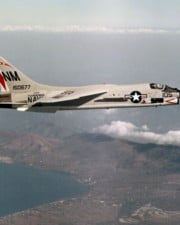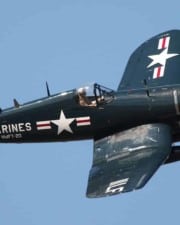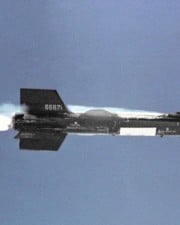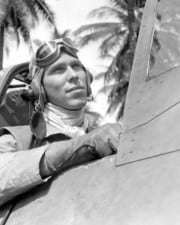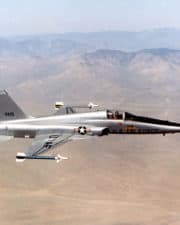Often “remembered” as a “Forgotten War,” the Korean War ushered in an unforgettable age of modern warfare, particularly in the form of jet-to-jet aerial combat. These jets that battled above Korea (and a couple that never did) defined the era.
Though not technically the start of the jet age of aerial combat (technically a few debuted at the very end of WWII), the Korean War was nevertheless the dawn of jet fighters as a force in military combat. After they hit the scene in Korea, propellered fighters were obsolete.
The dawn of the jet age didn’t always come smoothly, however. Early jets such as the Curtiss-Wright XF-87 Blackhawk and Northrop F-89 Scorpion never quite made the cut for the USAF in Korea, making them footnotes of progress in air force history without entering combat.
Other craft, however, saw a trial by fire in the skies. Banshees, Panthers, Skyknights, Starfires, and other USAF fighters scored some of the first jet success on the American side, while the venerable MiG-15 saw combat for the Soviet-backed North Korean side.
These are the top 10 Korean War fighter jets from both sides.
1. McDonnell F2H Banshee
Used from 1948 to 1961 by the United States Air Force and Marine Corps, the Korean War was the Banshee’s war – even if many pilots called it the “Banjo.” It performed well at higher altitudes, making it an ideal choice as an escort aircraft, although it mostly flew reconnaissance missions.
The United States feared that they might become embroiled in a USSR-provoked war while they were in Korea. Operation Steve Brody would’ve sent four Banshees that would have launched from a cruiser near Greece and would monitor the Black Sea for any signs of Soviet movement, before Secretary of Defense Robert Lovett nixed the plan.
The F2H Banshee measured 48 ft 2 in., had a maximum speed of 580 mph as powered by 2xWestinghouse J34-WE-34turbojet engines, a combat range of 1,168 mph, and could be armed with 4×20 mm Colt Mk 12 cannons, 8×60 lb rockets, and various types of bombs.
2. Douglas F-10/F3D Skyknight
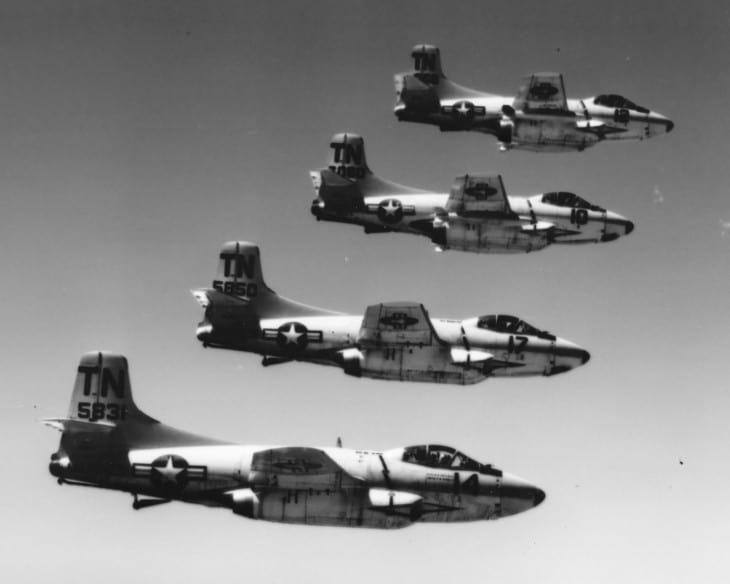
Making its debut in the Korean War, the Skyknight, despite not being as famous or widely used as the Sabre, carved out a niche for itself as a successful night fighter, downing several MiG-15s while only sustaining one loss.
On November 2, 1952, a Skyknight piloted by Major William T. Stratton, Jr. was able to score the first jet-to-jet intercept accomplished with night radar, while Captain O.R. Davis and Warrant Officer Ding Fessler downed the first MiG of the war (near Pyongyang no less) on November 8.
The Skyknight measured 45 ft 5 in., had a maximum speed of 530 mph, was powered by 2×Westinghouse J34-WE-36turbojet engines, and could be armed with 4×20 mm Hispano-Suiza M2 cannons, Tiny Tim rockets, Sparrow air-to-air missiles, and bombs. (It wasn’t a sleek fighter, earning nicknames like “Willie the Whale” and “Drut” – read it backwards.)
3. Grumman F9F Panther

Both astronaut and Senator John Glenn and baseball legend Ted Williams took to the skies for the US Navy in the cockpit of a Panther during the Korean War. Neil Armstrong piloted an F9F in Korea as well, although he was forced to eject when his plane crashed.
The Panther saw extensive use in Korea, but was not widely purchased by other countries following the war. Only Argentina purchased it, and it became the first Argentine jet to land on an aircraft carrier before they retired the model as well in 1969.
The Panther measured 38 ft 10 in., was able to attain a maximum speed of 579 mph via 1×Pratt & Whitney J48-P-6A turbojet, and was armed with 4×20 mm AN/M3 cannons.
4. Lockheed F-94 Starfire
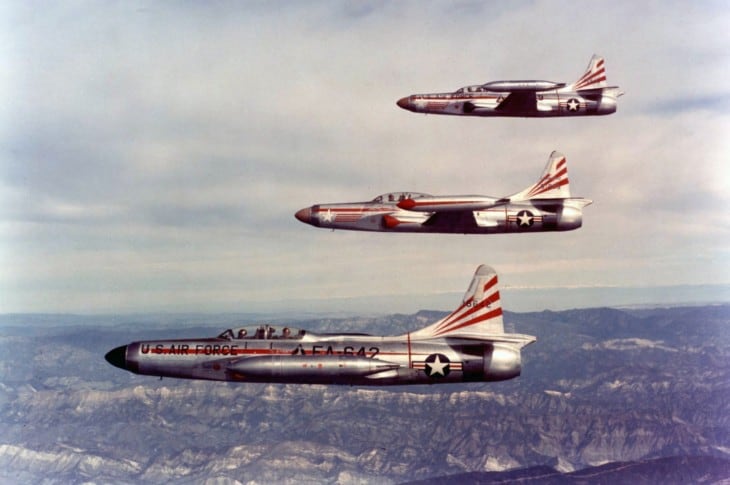
Although they were only in operation for barely more than a decade, the F-94 Starfire’s still left their mark on the Korean War. They first arrived in Japan at Johnson Air Base on March 31, assigned to the 339th Fighter-All Weather Squadron, with missions following soon thereafter.
Because of their placement, many of the Starfighter’s missions were defensive in nature, protecting the US position in Japan while other pilots took the fight to the Korean Peninsula. However, they still did fly some sorties over North Korea as well.
The F-94 Starfighter measured 44 ft 6 in., had a maximum speed of 640 mph via 1 × Pratt & Whitney J48-P-5 centrifugal-flow turbojet engine, and was able to be armed with 24 or 48 × 2.75 in. Mk 4/Mk 40 Folding-Fin Aerial Rockets.
5. NAA F-86 Sabre

One of the most famous jet fighters of the war as well as the entire era, the Sabre was the first swept fighter in the USAF and, in its service during the Korean War, took part in some of history’s first jet versus jet aerial battles.
Though USAF pilots had a huge advantage over inexperienced Chinese and North Korean pilots in these sorties, Soviet pilots secretly flew the MiG-15s early on. Much of this combat took place in “MiG Alley,” a part of the Korean Peninsula notorious for its high concentration of MiG jet fighters.
The F-86 Sabre measured 37 ft 1 in., could obtain a maximum speed of 687 mph courtesy of 1×General Electric J47-GE-27 turbojet engine, and could be armed with 6×0.50 in. M3 Browning machine guns, and several types of rockets and bombs.
6. Curtiss-Wright XF-87 Blackhawk
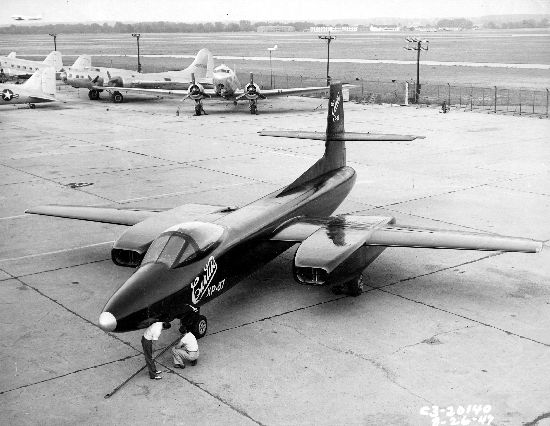
While not a fighter jet that took part in the Korean War, this prototype set the stage for jets like the F-89 Scorpion and F-94 Starfighter. The Blackhawk was designed with the idea of being one of the first jets in the USAF, but it lost its bid.
The Blackhawk first took flight on March 5, 1948, and the contract for its adoption was cancelled on October 10, 1948. The top speed for the Blackhawk was actually slower than had been expected, but the prototypes otherwise performed well, but not well enough to beat out the Scorpion.
The Blackhawk prototypes measured 62 ft 10 in. and had a maximum speed of 600 mph 4×Westinghouse XJ34-WE-7 turbojet engines, and 4×20 mm AN/M2 cannons.
7. Northrop F-89 Scorpion
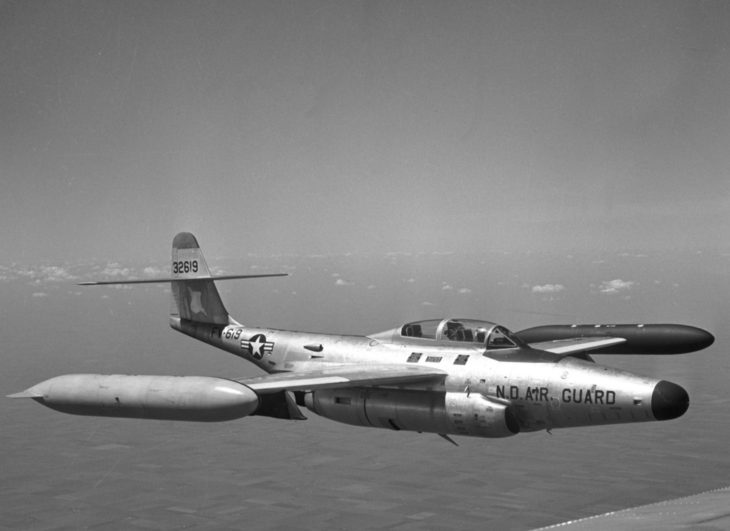
So how did the Scorpion do after it had beaten out the Blackhawk? As a matter of fact, it did not make the cut for a spot in the USAF during the Korean War, either.
In fact, the F-89 Scorpion practically never saw combat at all before it was retired in 1969, a relatively short period of time after it had first been adopted just before the Korean War in September 1950. If there’s a silver lining to that it’s that many are well-preserved in museums.
The Scorpion measured 53 ft 9.5 in., was able to attain a maximum speed of 645 mph courtesy of 2×Allison J35-A-35 afterburning turbojet engines, and could be armed with “Mighty Mouse” Mk 4/Mk 40 Folding-Fin Aerial Rockets.
8. Republic F-84 Thunderjet
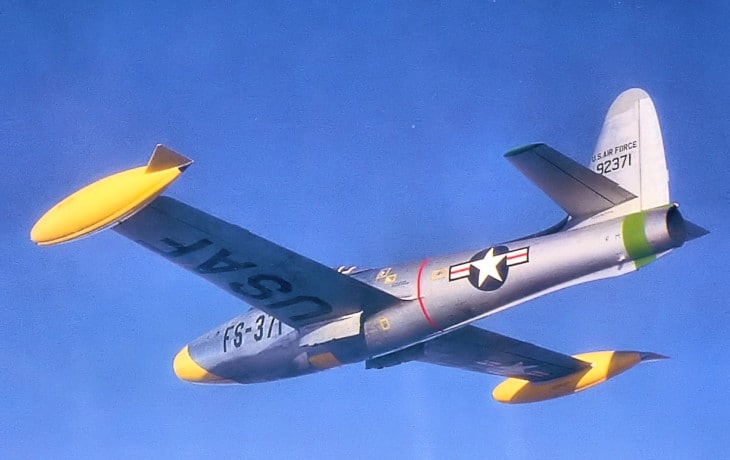
One of the most prolific fighters of the war, the Thunderjet was responsible for 60% of all ground targets destroyed by the United States during the war, though in one-on-one fights they were overmatched by MiG-15s. After the war, it became the first aircraft to be zero launched from a trailer.
The Thunderjet proved to be a popular aircraft to export, with Belgium, Denmark, France, Greece, Iran, Italy, the Netherlands, Norway, Portugal, Taiwan, Yugoslavia, and other air forces ordering them.
The Thunderjet measured 38 ft 1 in., was able to attain a maximum speed of 622 mph thanks to 1×Allison J35-A-29 turbojet engine, and was able to be armed with 6×.50 in. M3 Browning machine guns and up to a 4,450 lb complement of rockets and bombs, including a Mark 7 nuclear bomb.
9. Lockheed P-80 Shooting Star
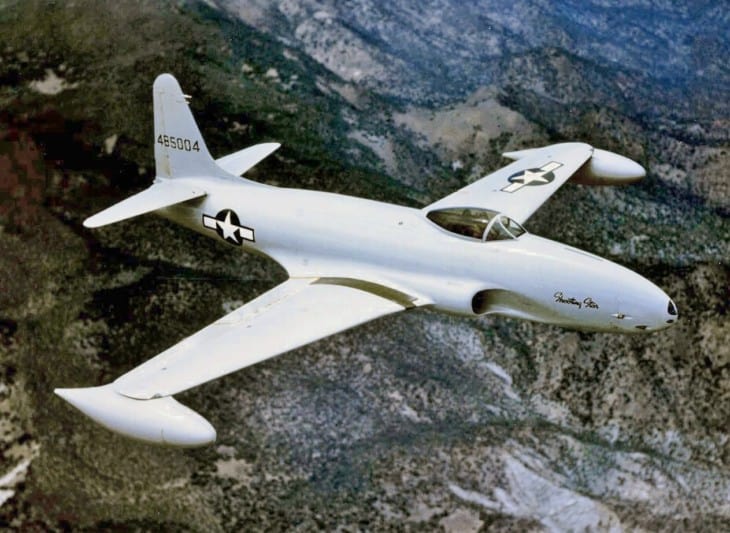
An unfortunate mark against its record, a Soviet claim to the first-ever jet fighter kill came against a P-80 Shooting Star, though a week later, the United States claimed to record the first-ever fighter kill with a P-80 downing a MiG-15 – which Soviet records likewise denied.
Either way, according to Lockheed 75% of North Korean/Chinese/Soviet casualties in the opening months of the war were due to the Shooting Star. Ten squadrons in the USAF operating in Korea used the P-80 Shooting Star, taking part in hundreds of sorties and playing a key role in the aerial war.
The P-80 Shooting Star measured 34 ft 5 in., could obtain a maximum speed of 594 mph thanks to 1×Allison J33-A-35 centrifugal compressor turbojet, and could be armed with 6×0.50 in. M3 Browning machine guns, 8×127 mm HVAR unguided rockets, and bombs.
10. Mikoyan-Gurevich MiG-15

The MiG line of jet fighters dominated the Soviet and Soviet-aligned side of the Cold War like few others, and the MiG is a perfect example of that. This gave it an edge during the Korean War when it was deployed on the China and Soviet-backed North Korean side.
More than 13,000 were manufactured and they saw extensive use in Korea, achieving great success against several US fighters. However, they were also used for defections from the North Korean side, with No-Kum Sok (latter Kenneth R. Rowe) flying his MiG-15 to Kimpo Air Base in South Korea to defect.
The MiG-15 measured 33 ft 1 in., had a maximum speed of 669 mph, and could be armed with 2×23 mm Nudelman-Rikhter NR-23 autocannons and 1×37 mm Nudelman N-37 autocannon.
Related Posts



